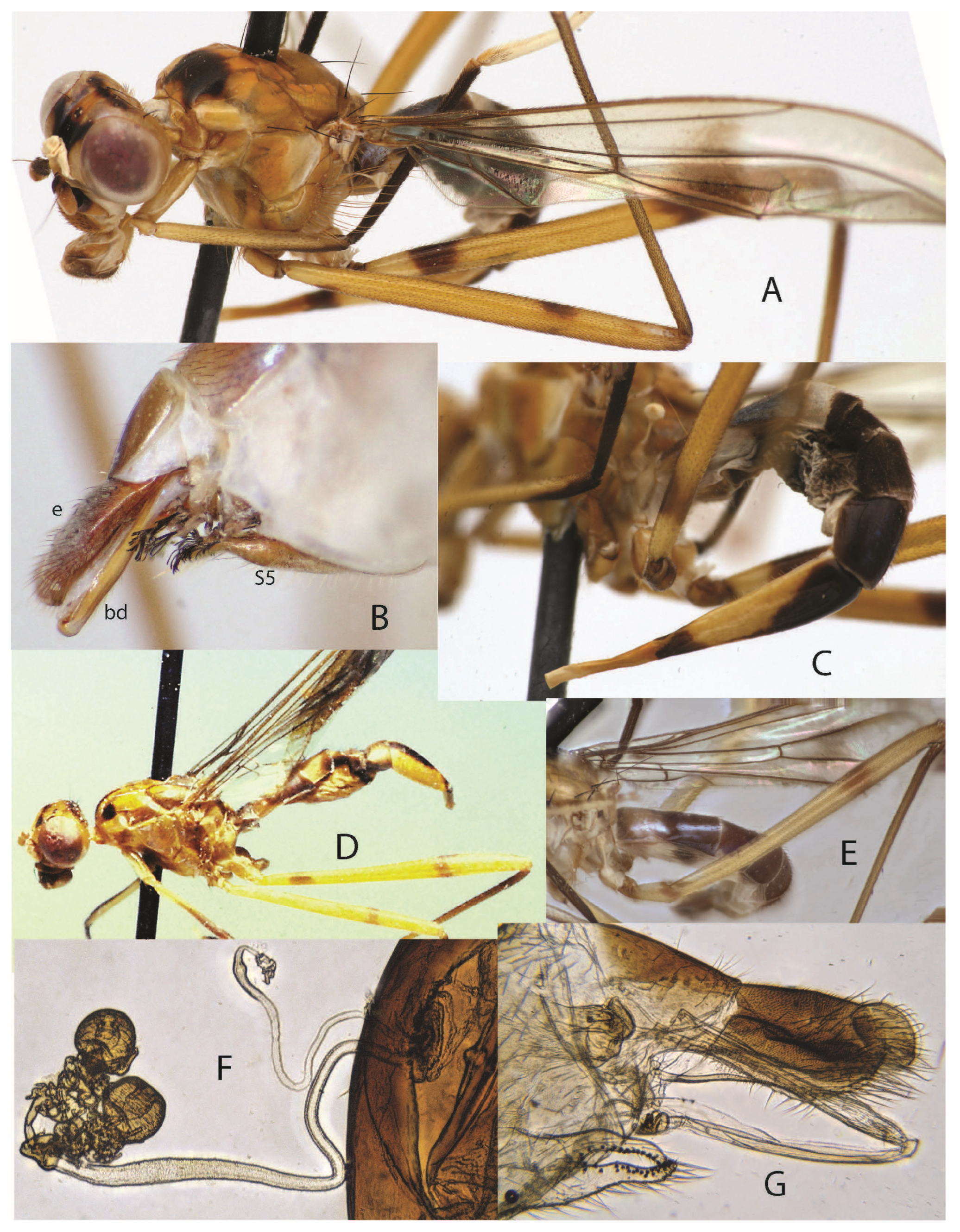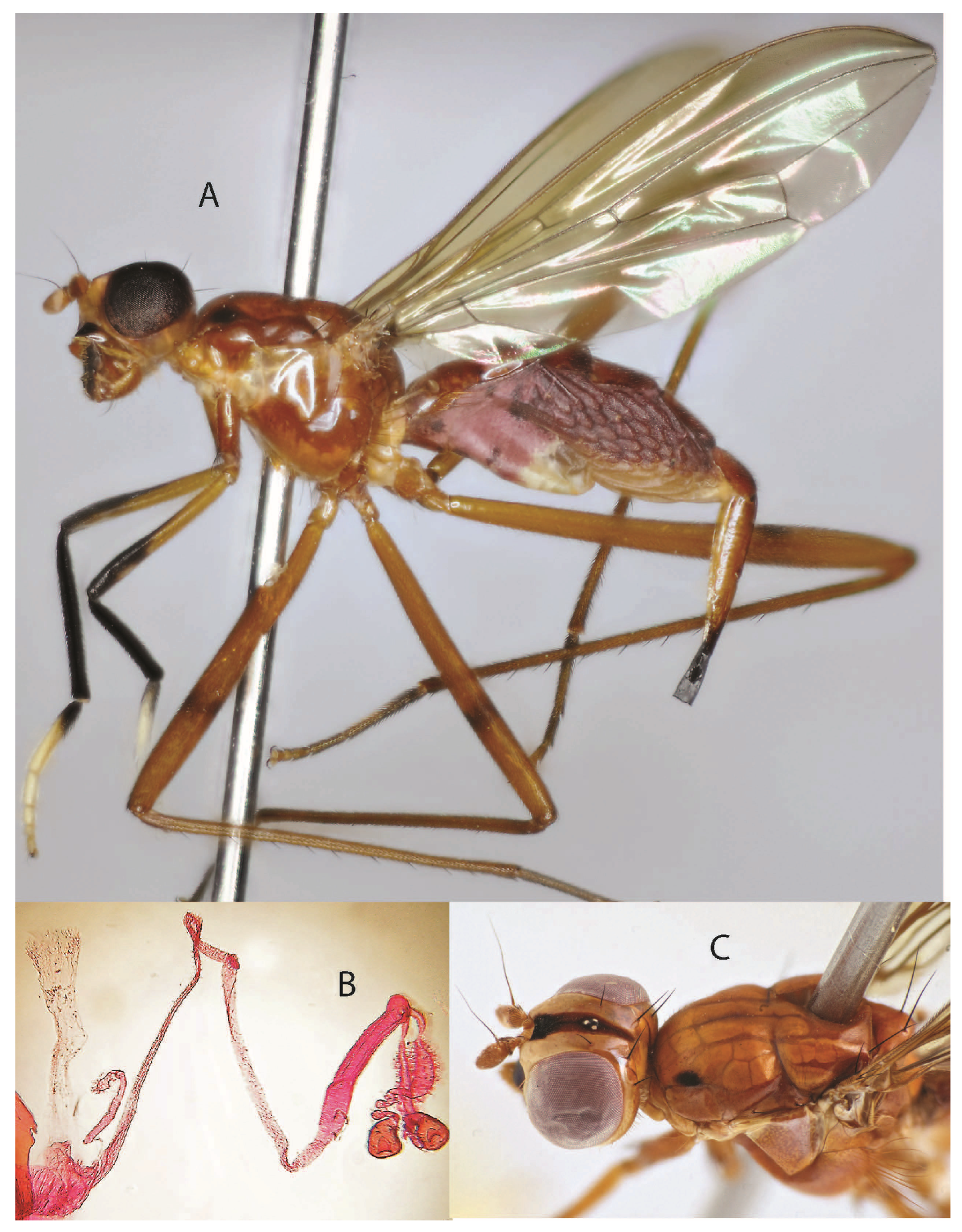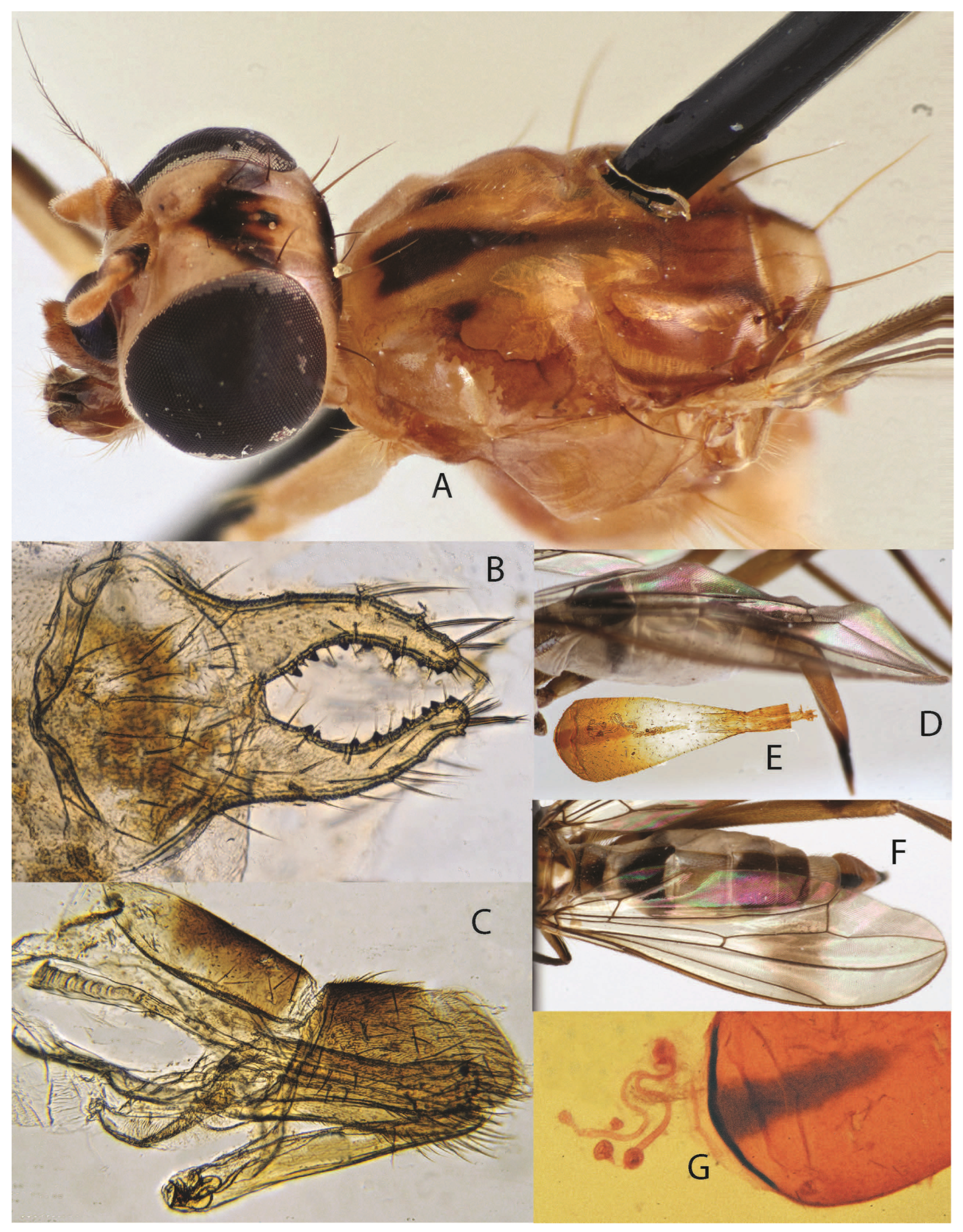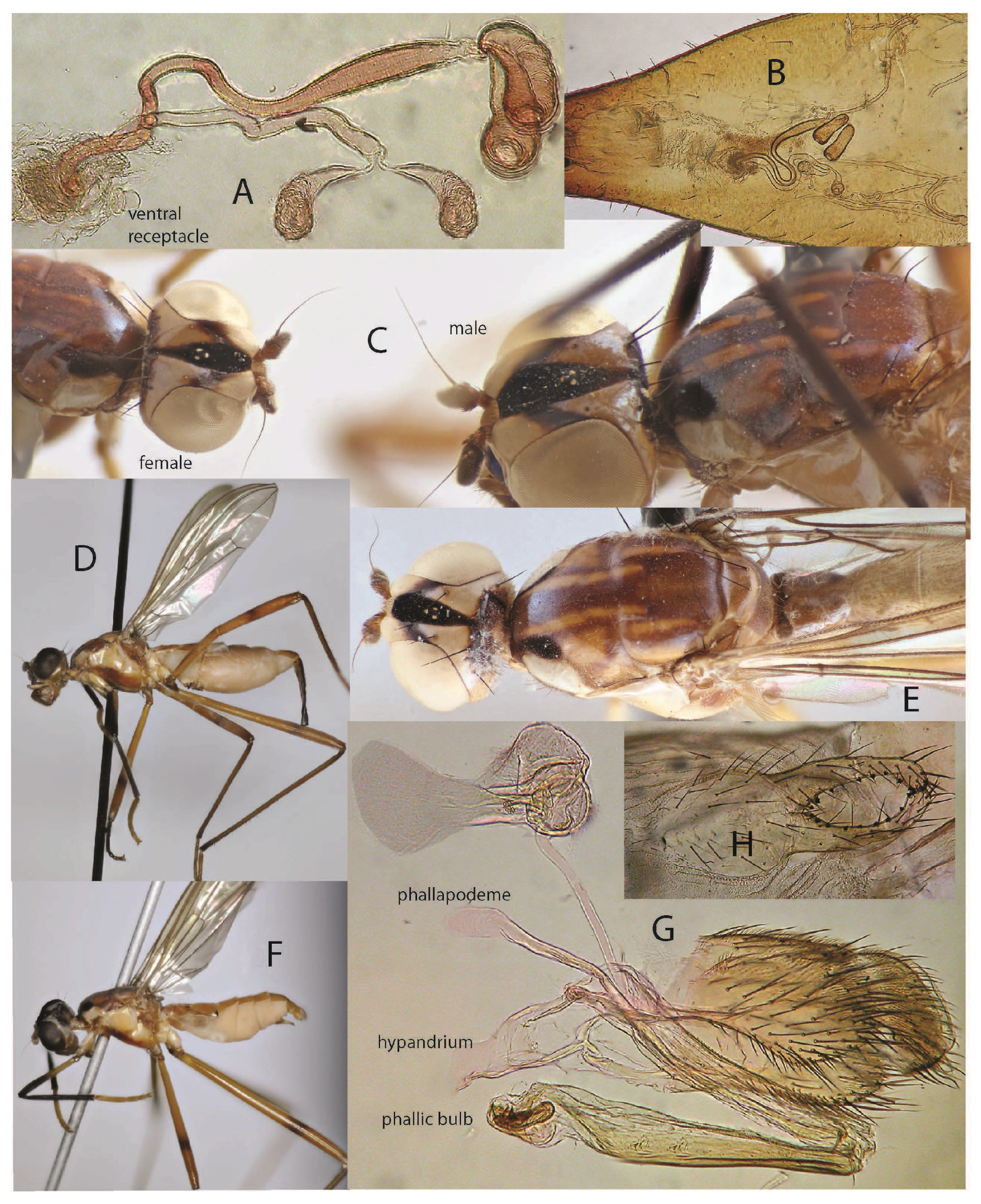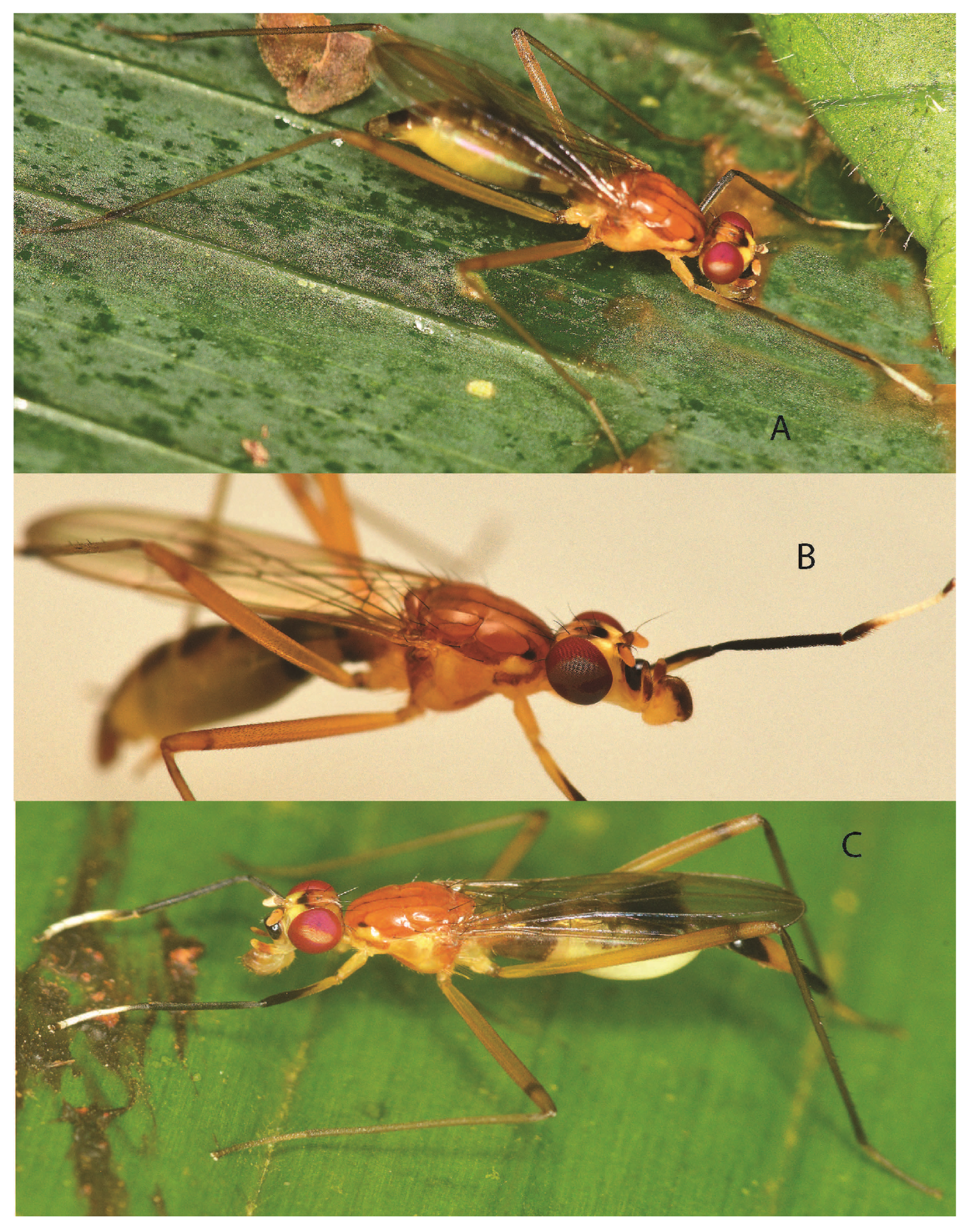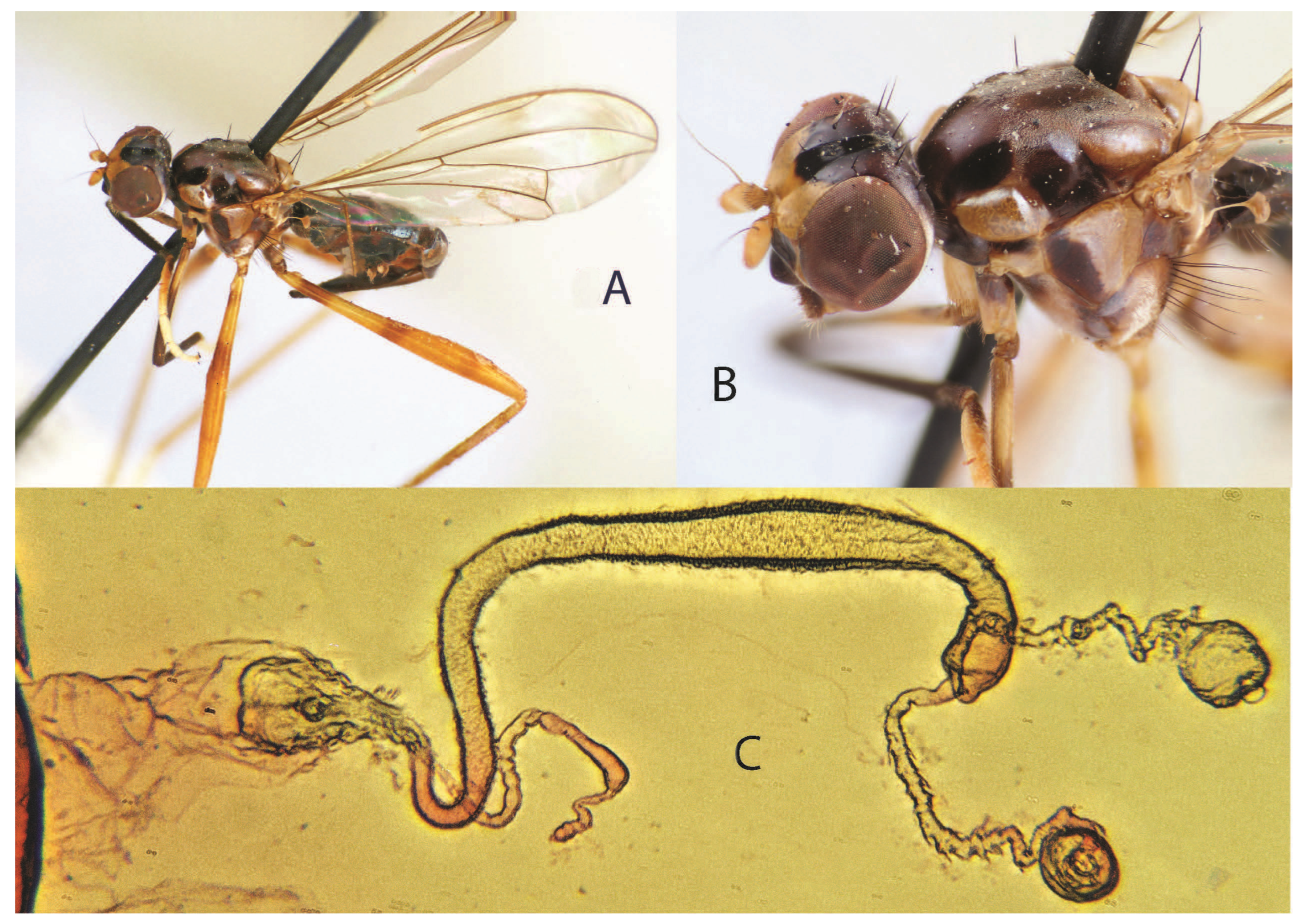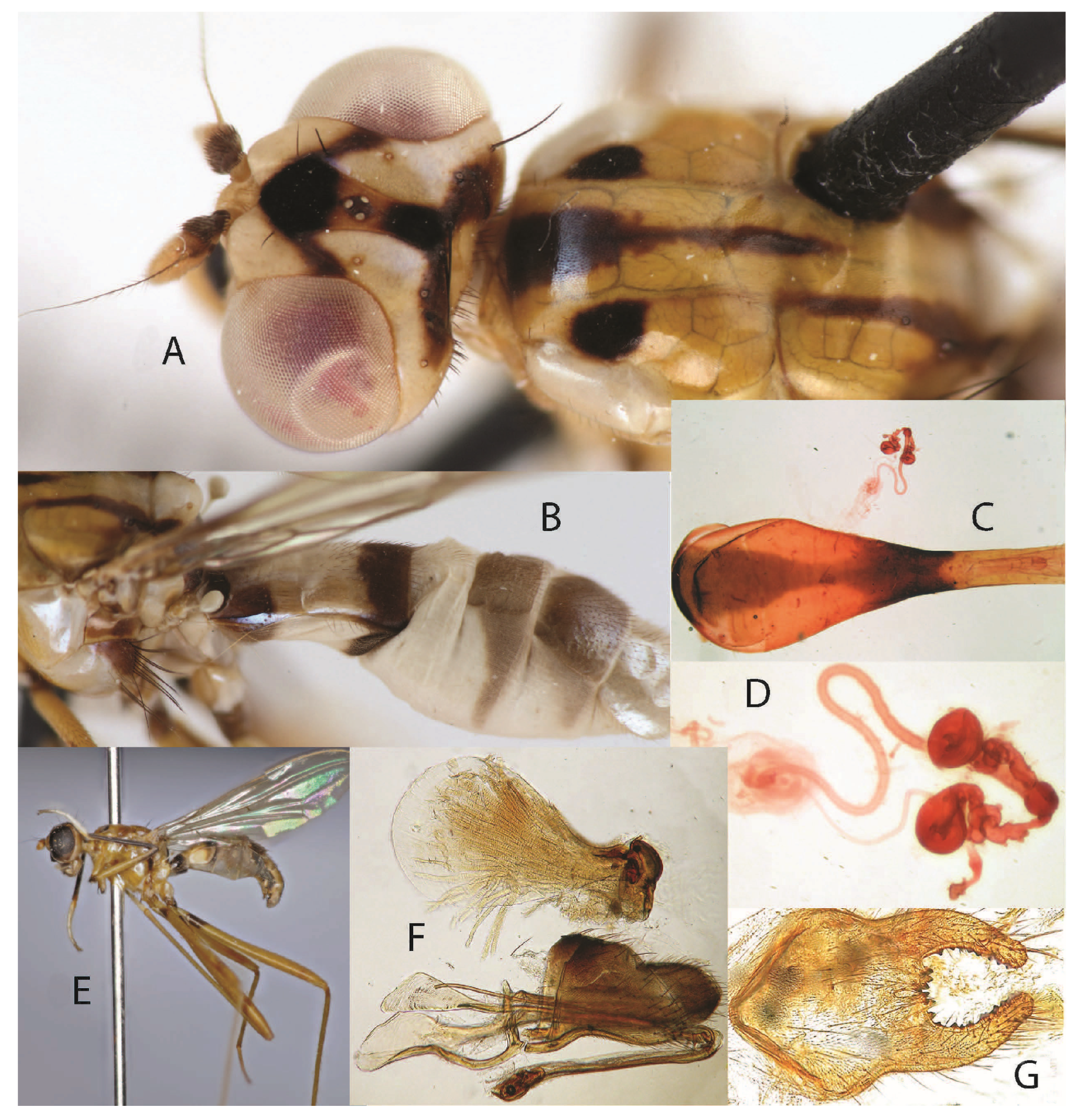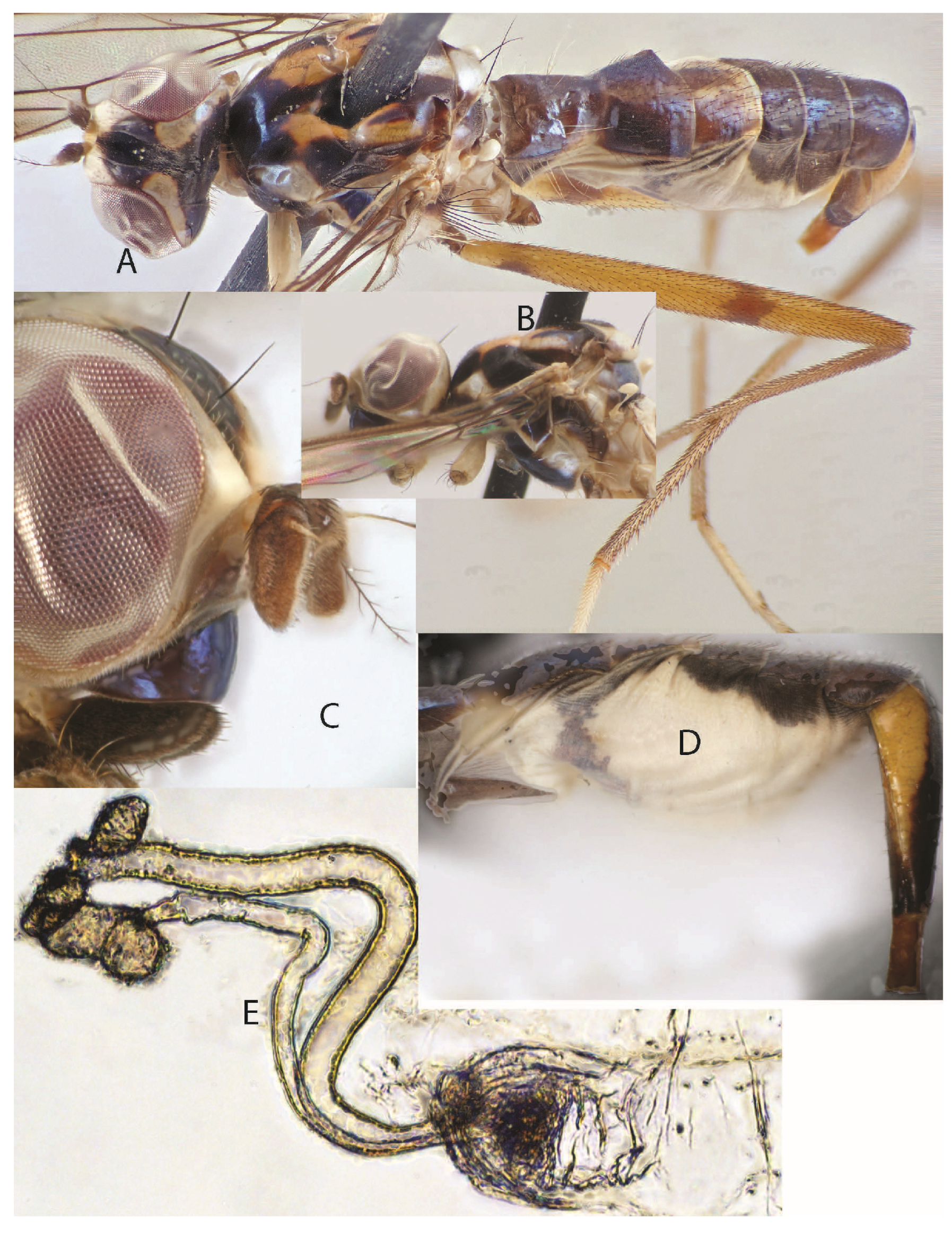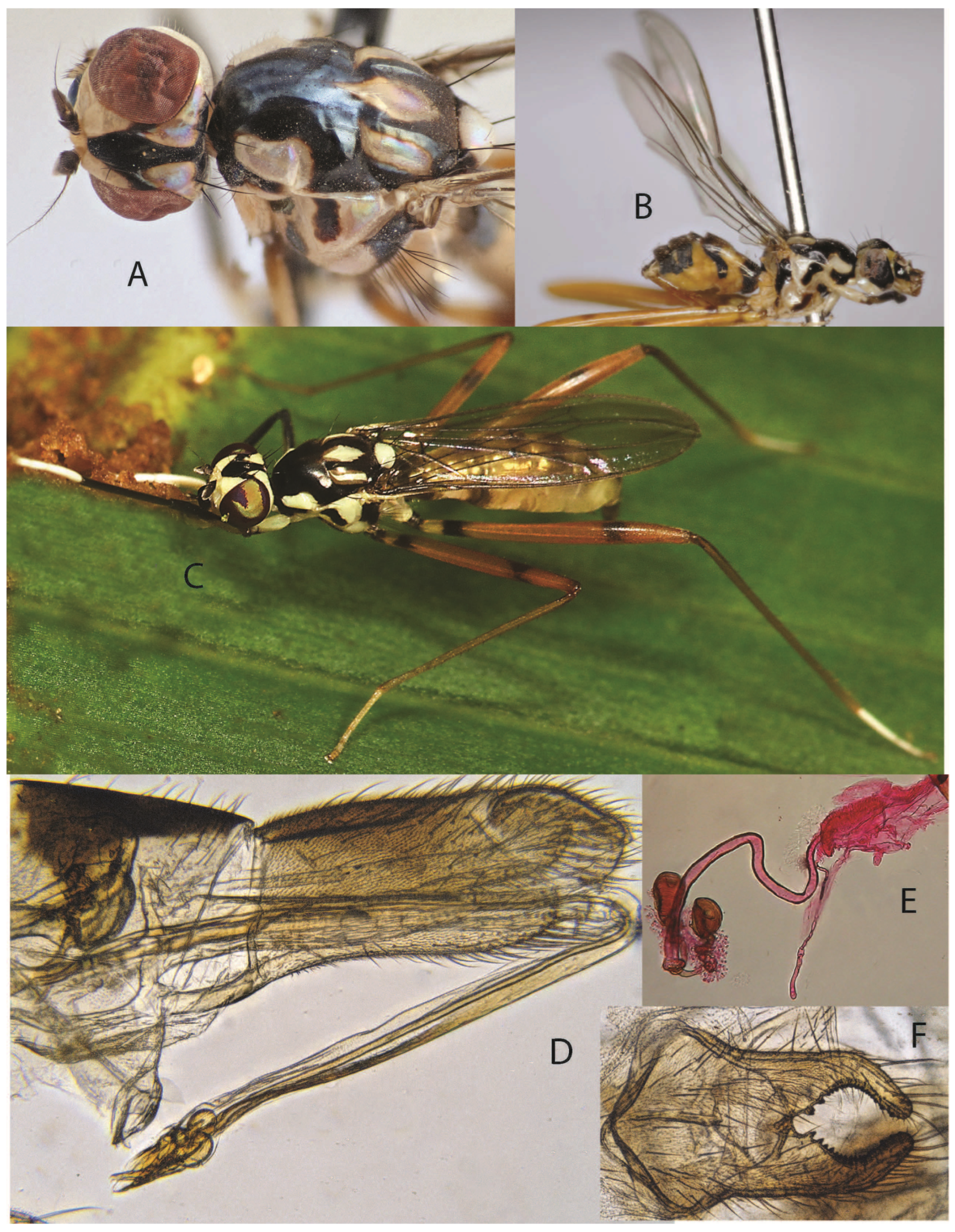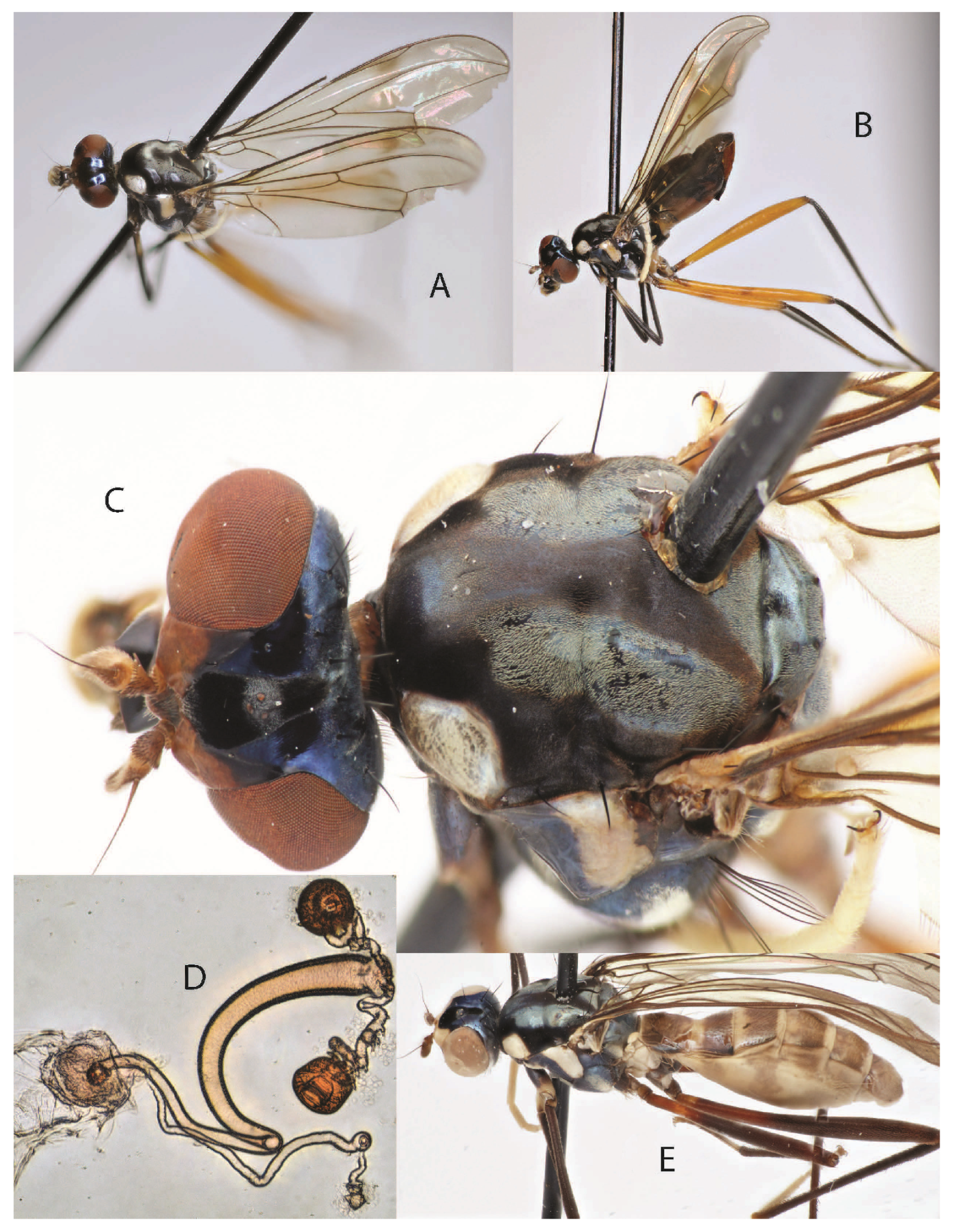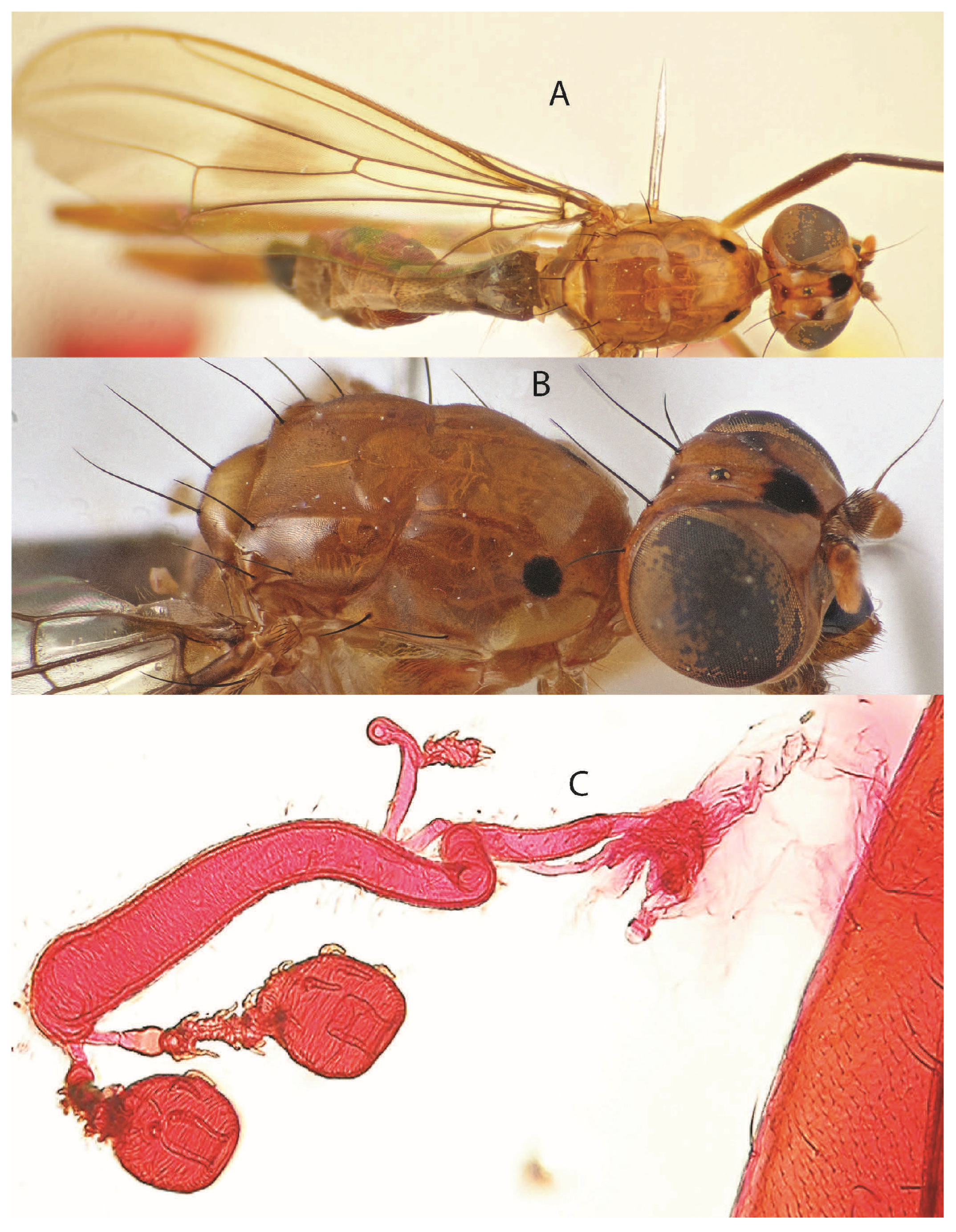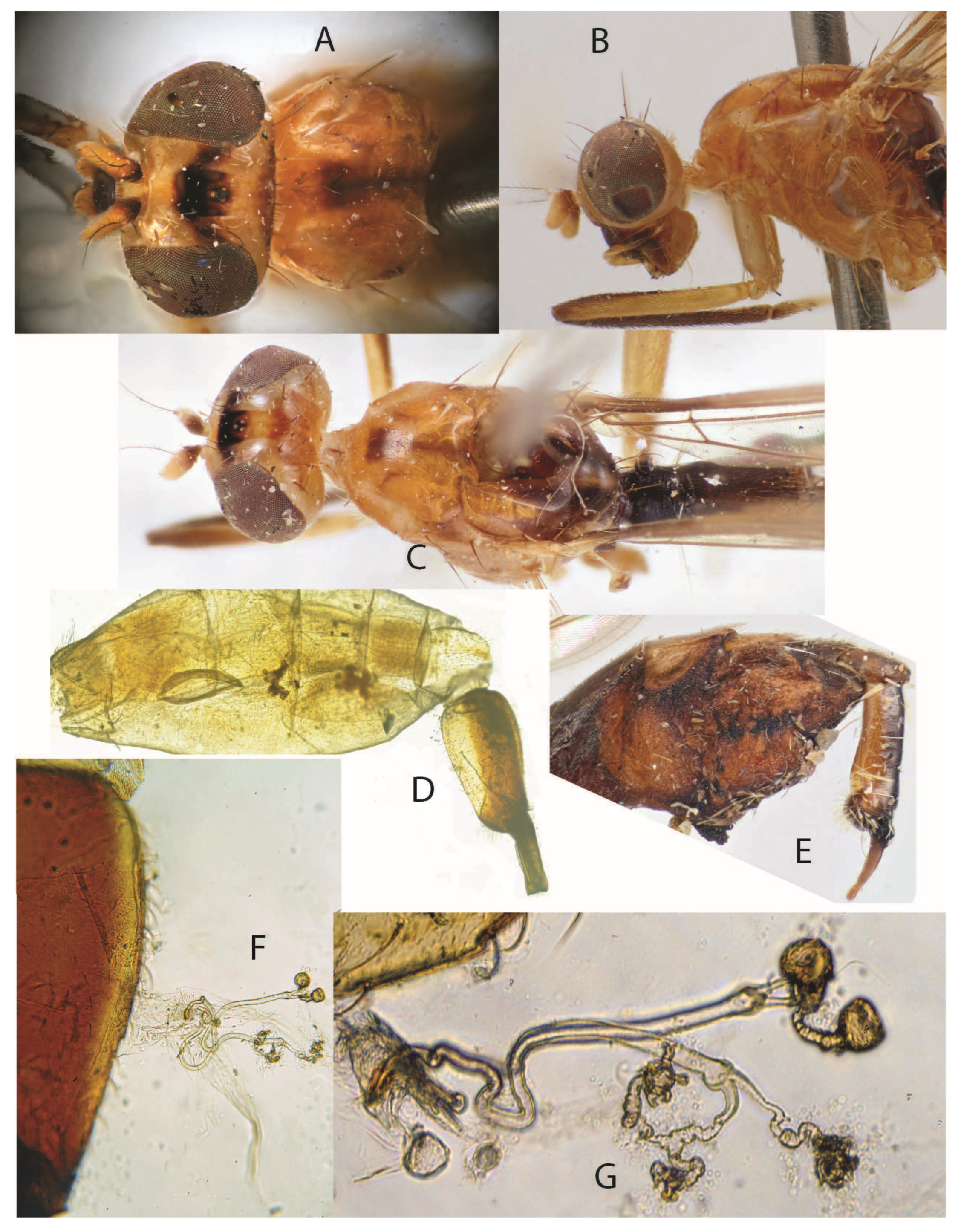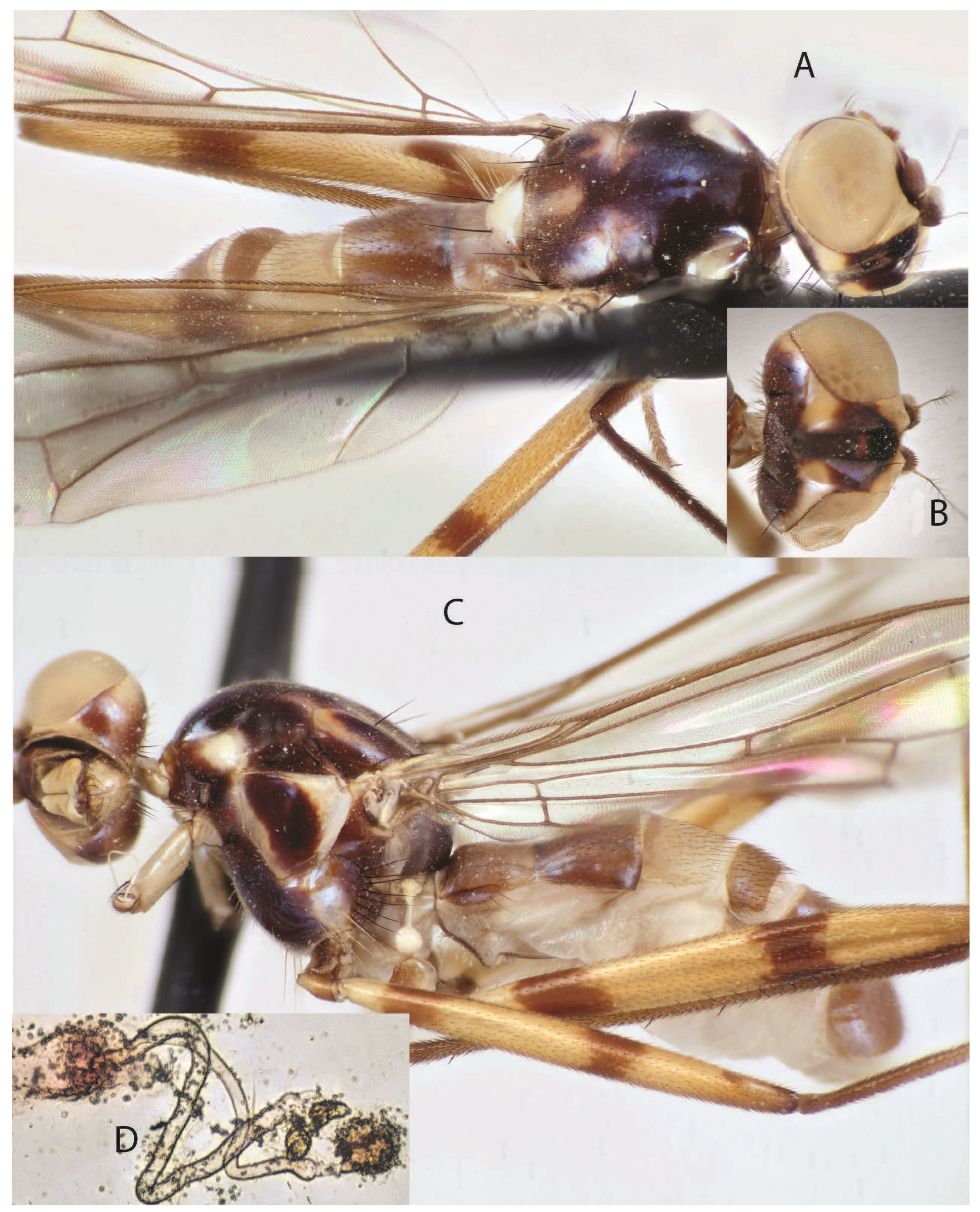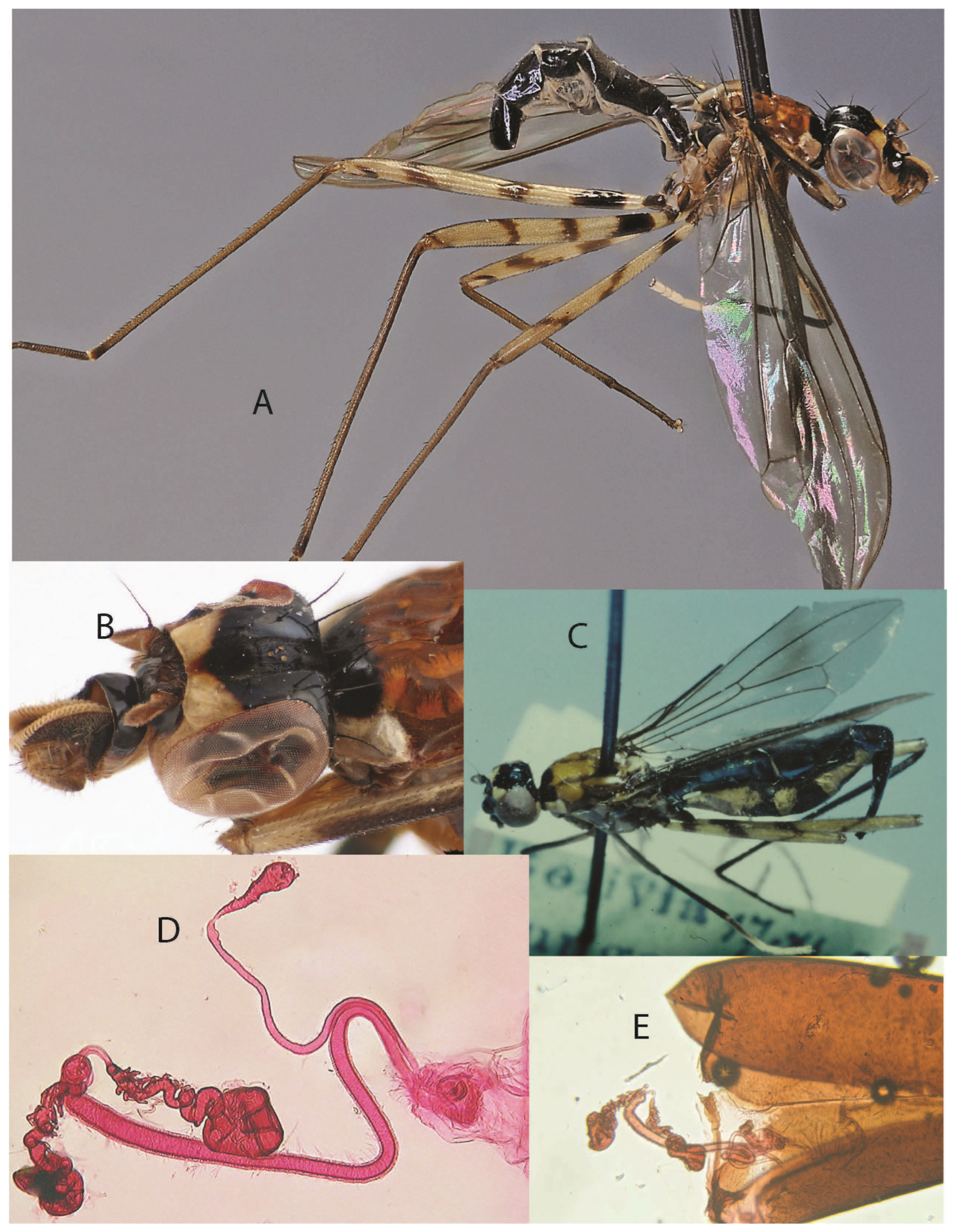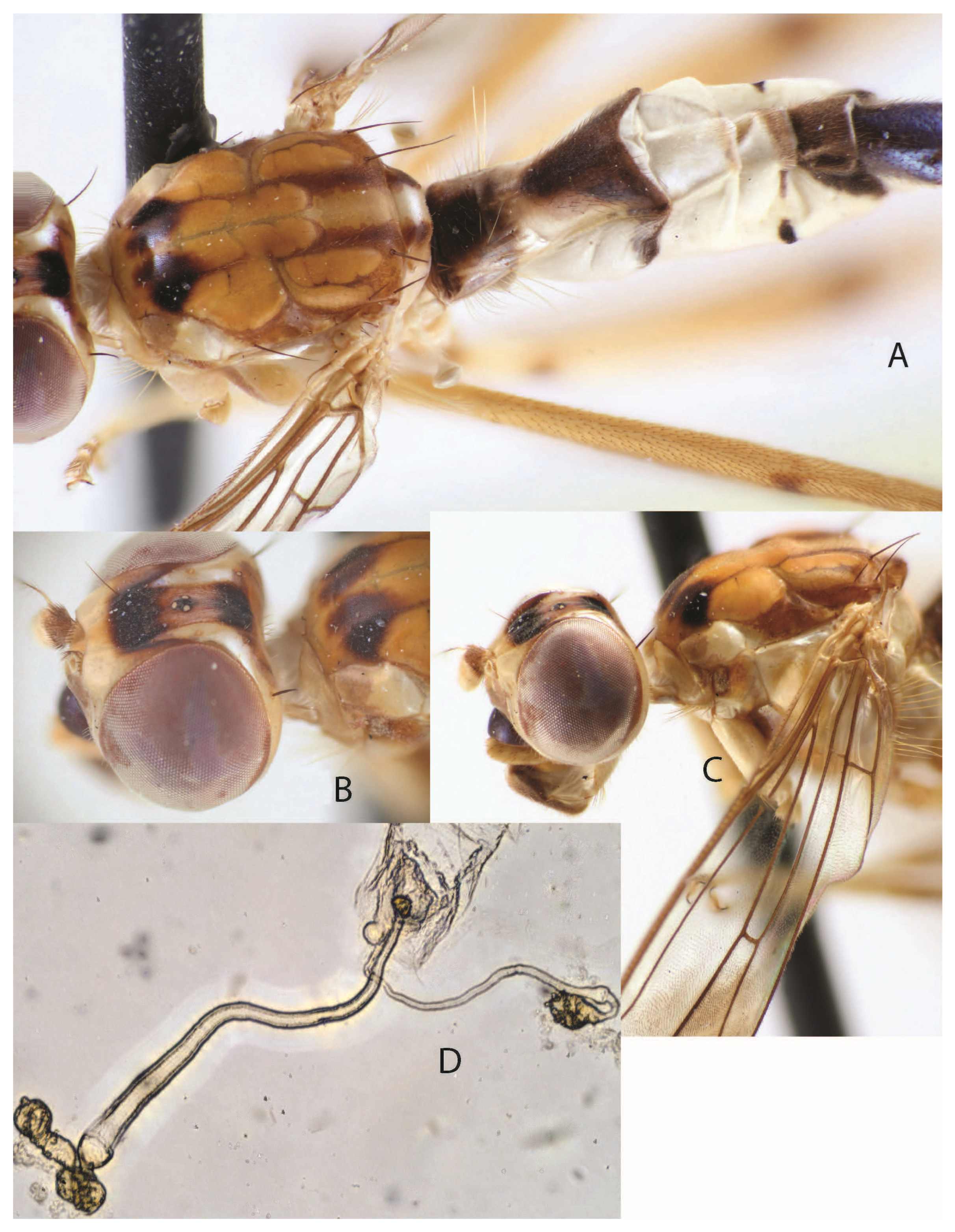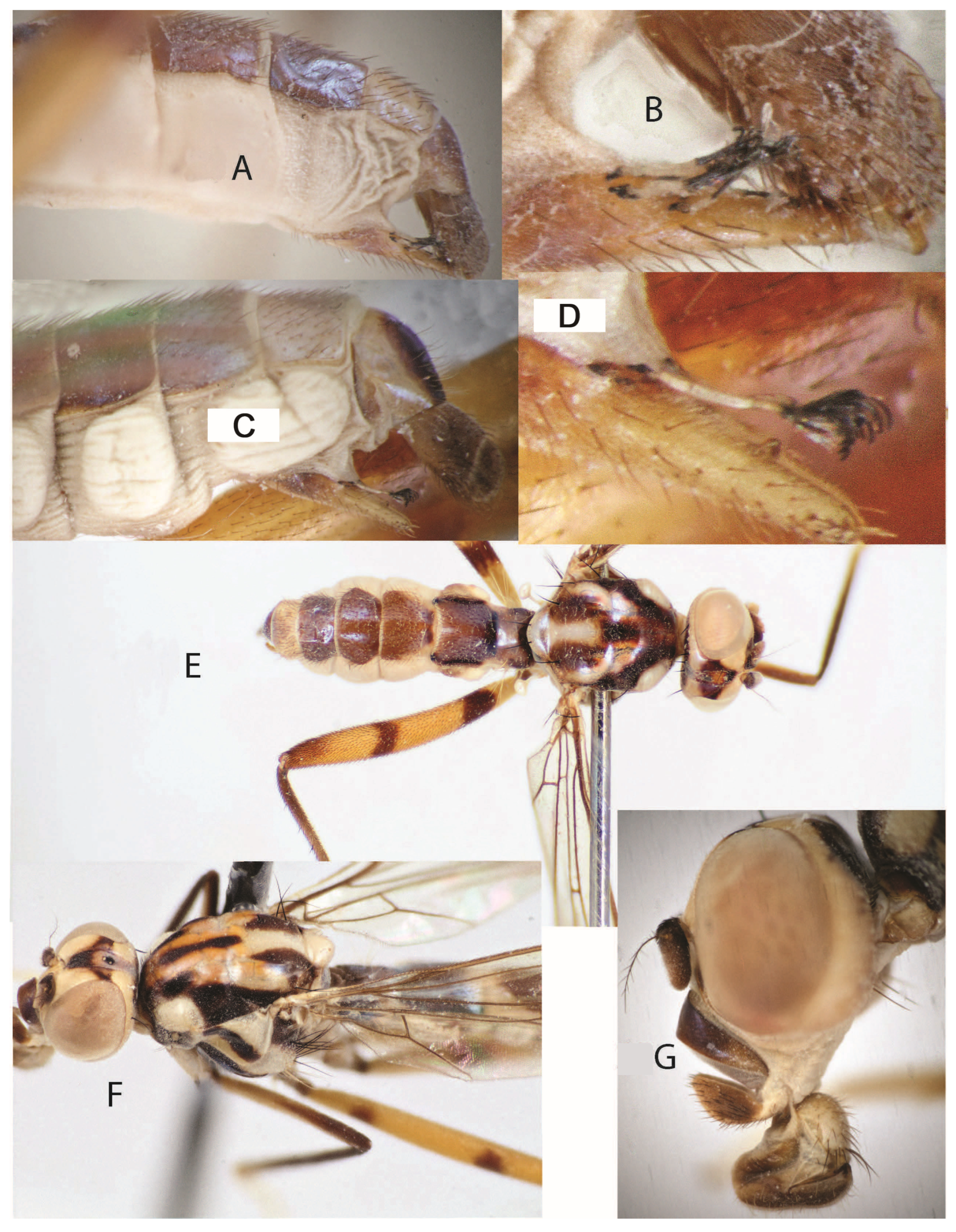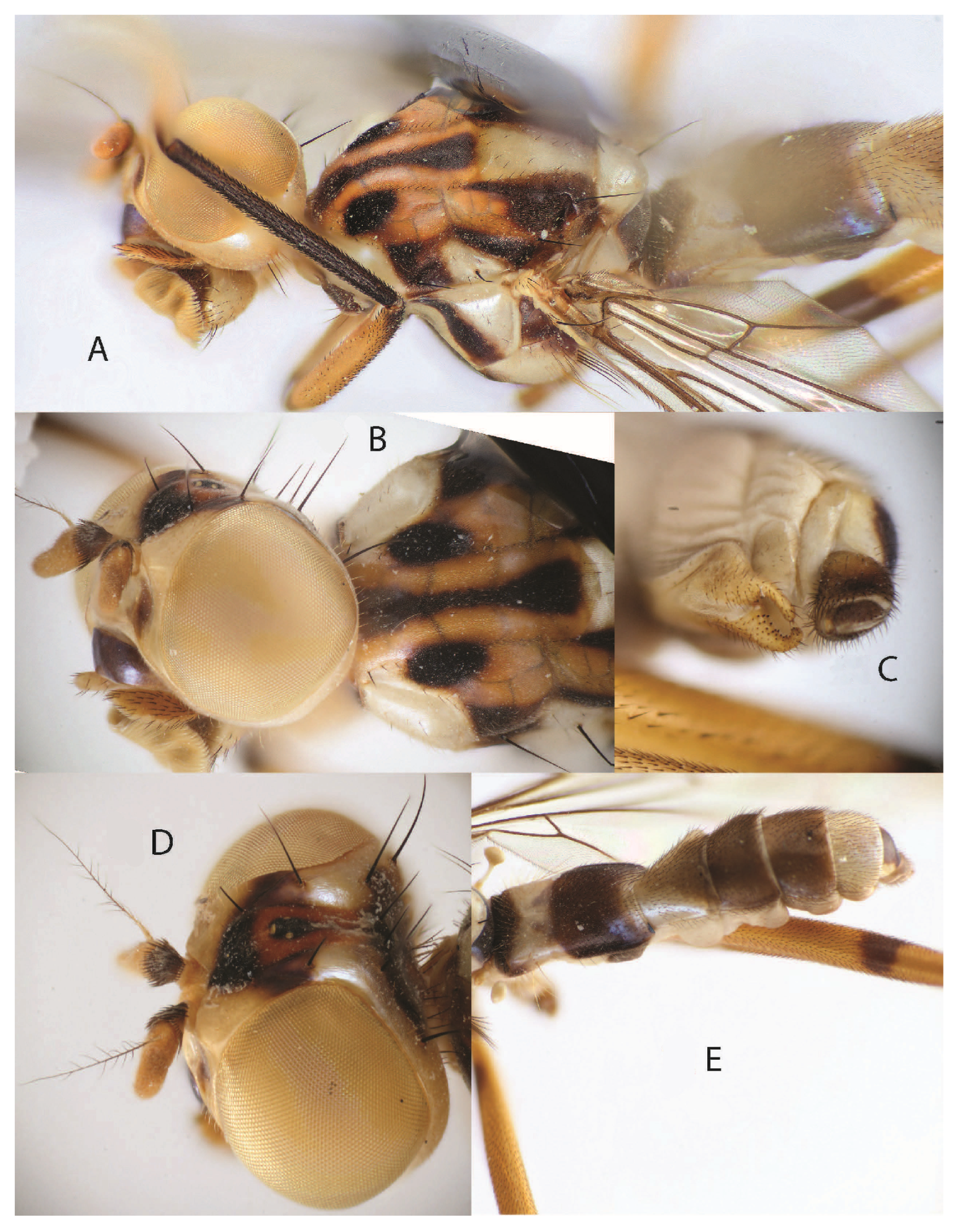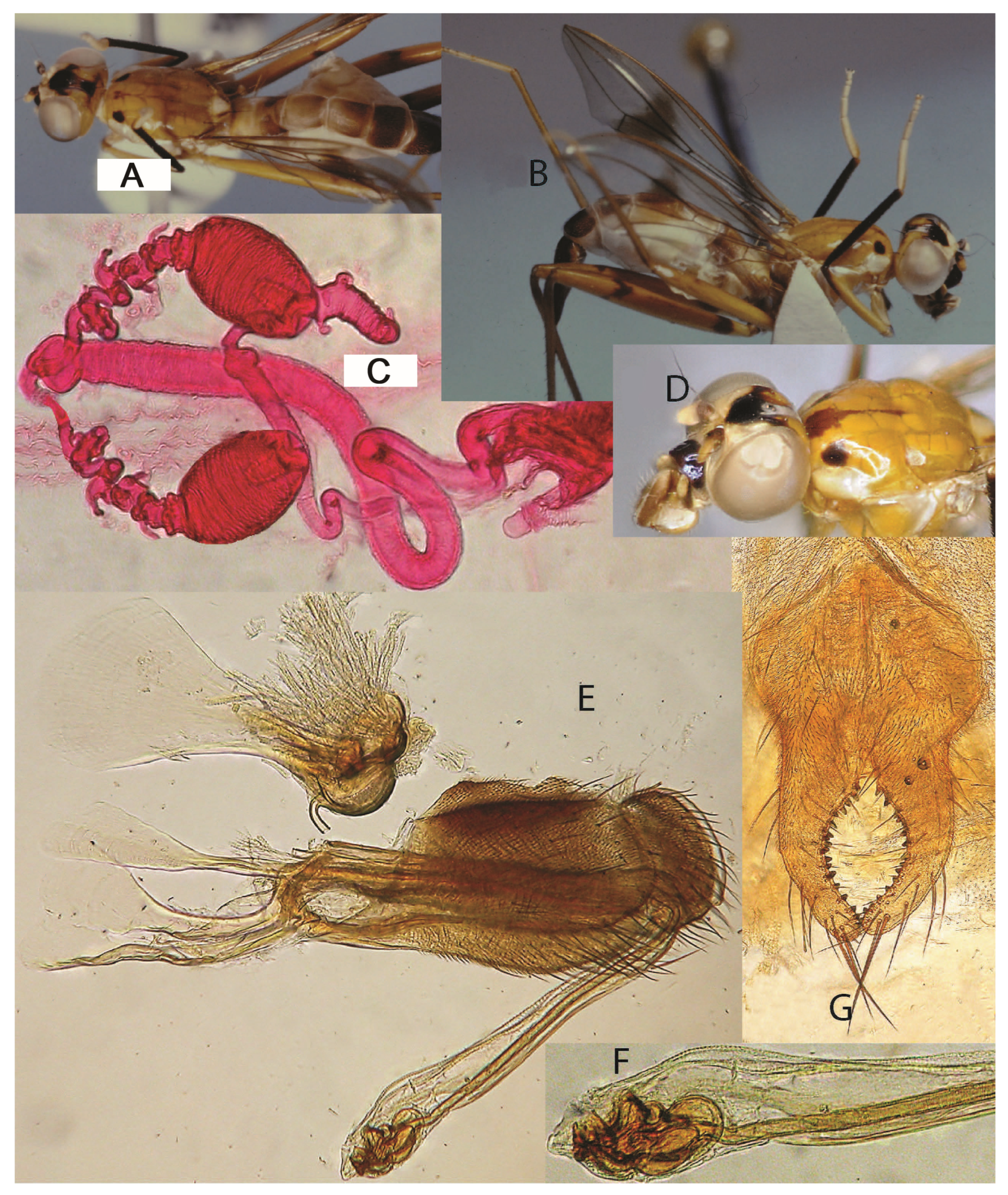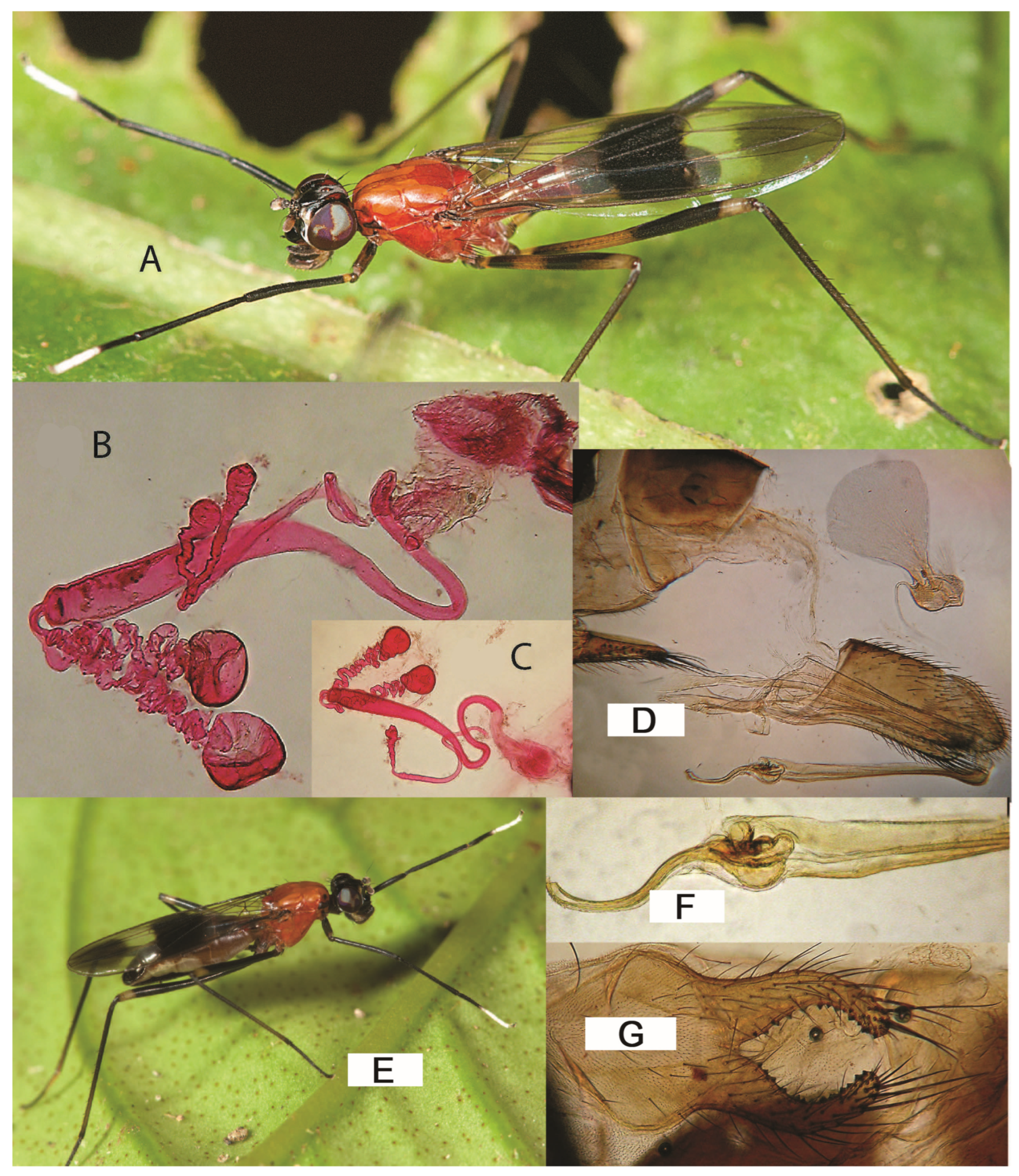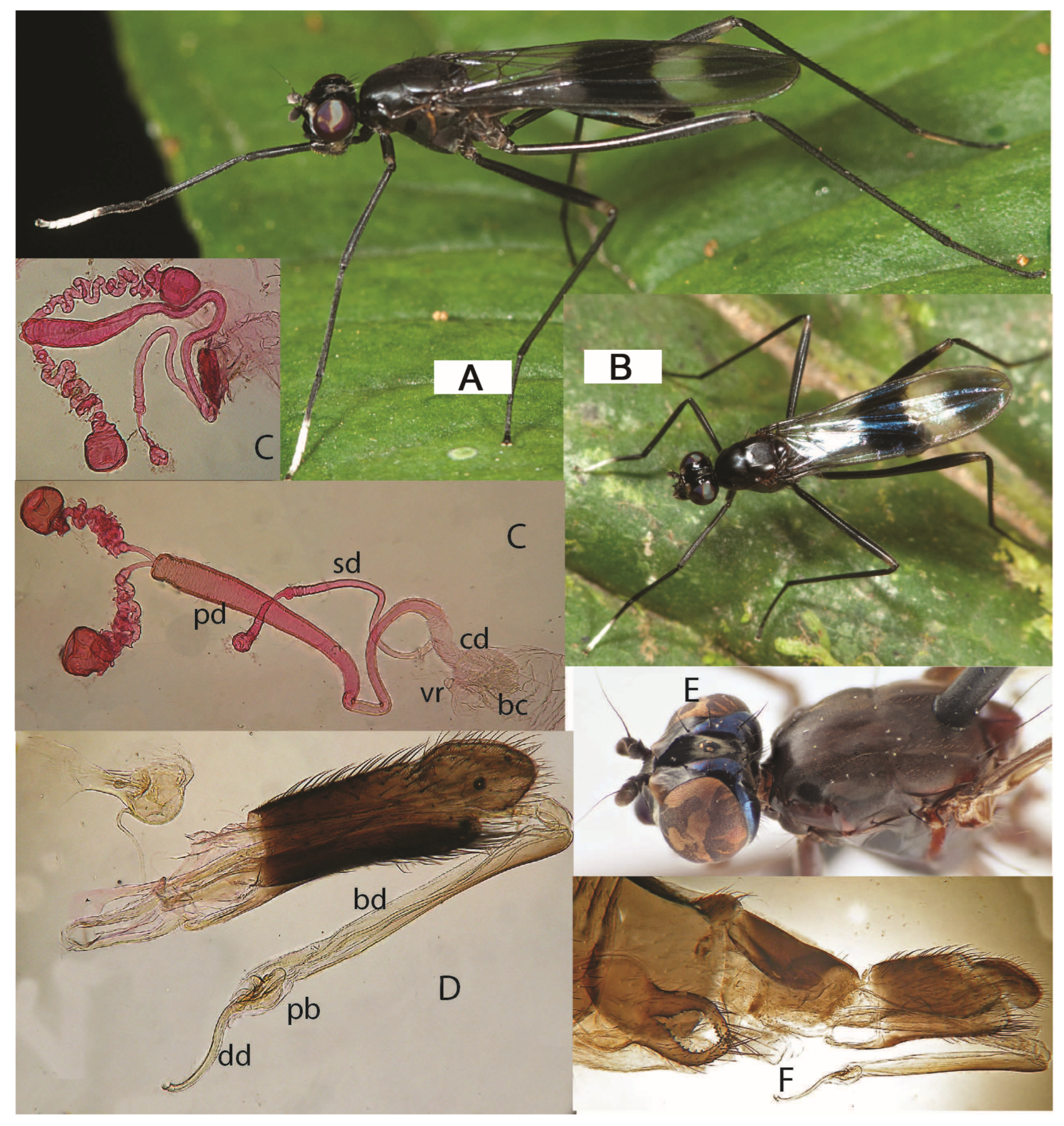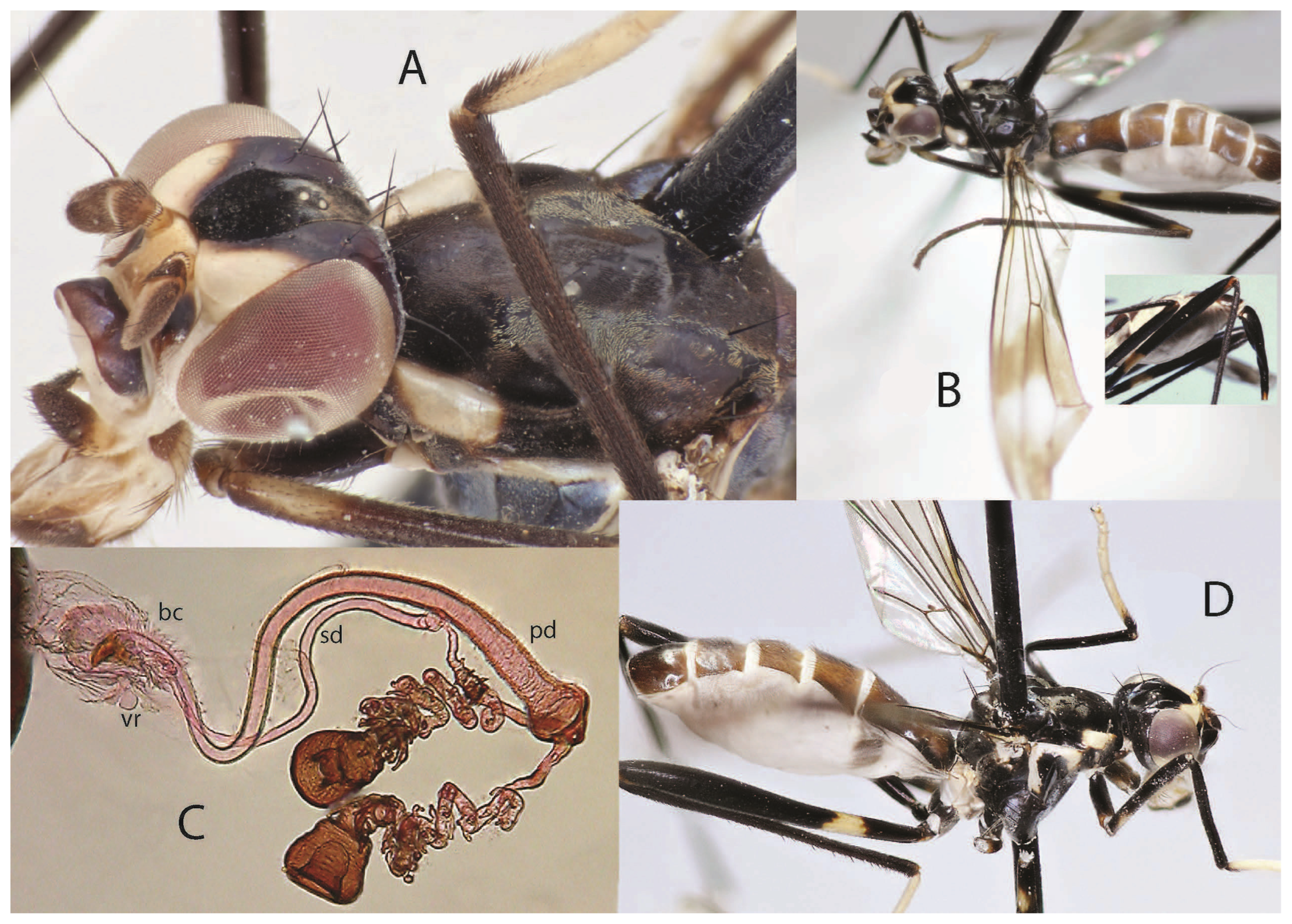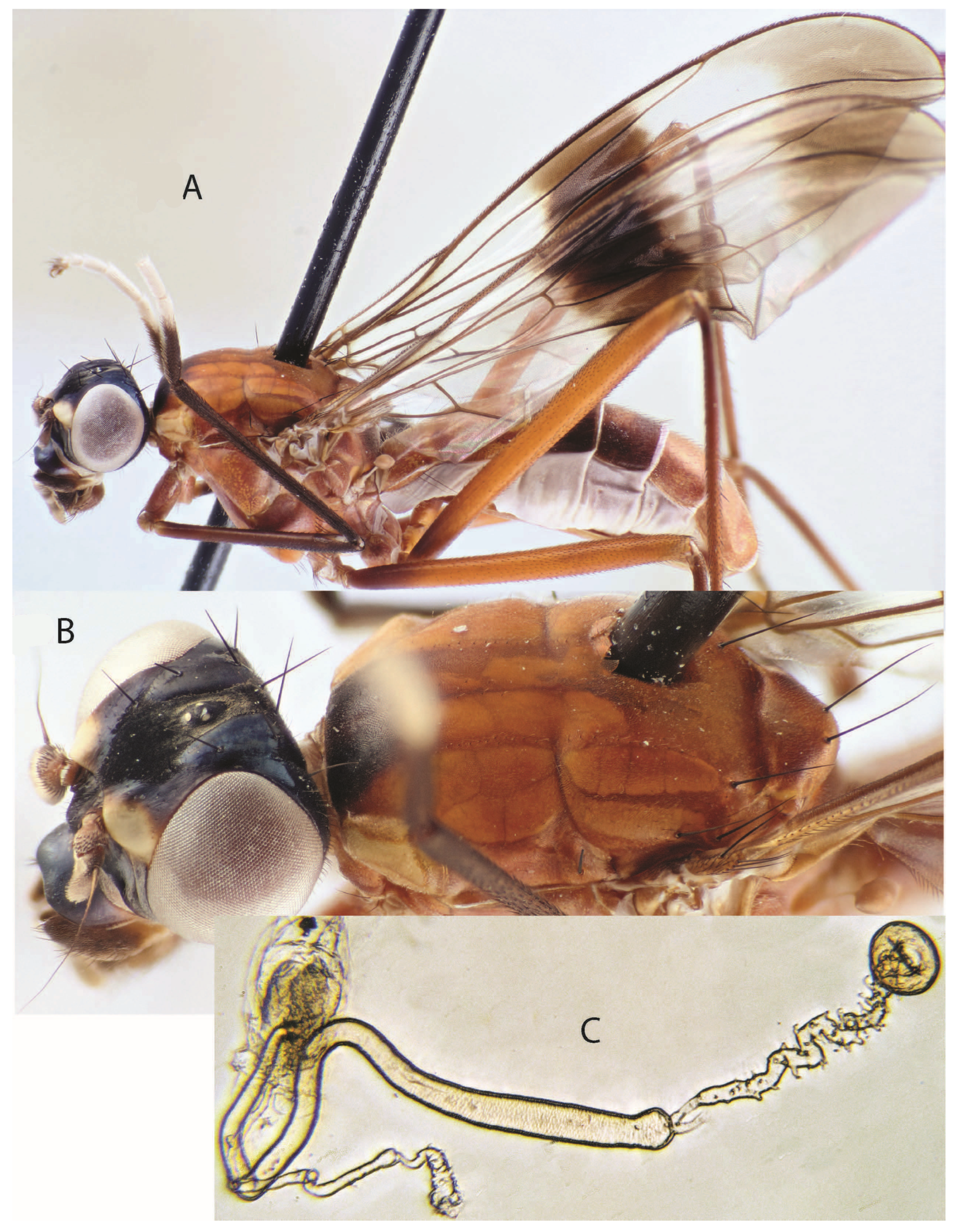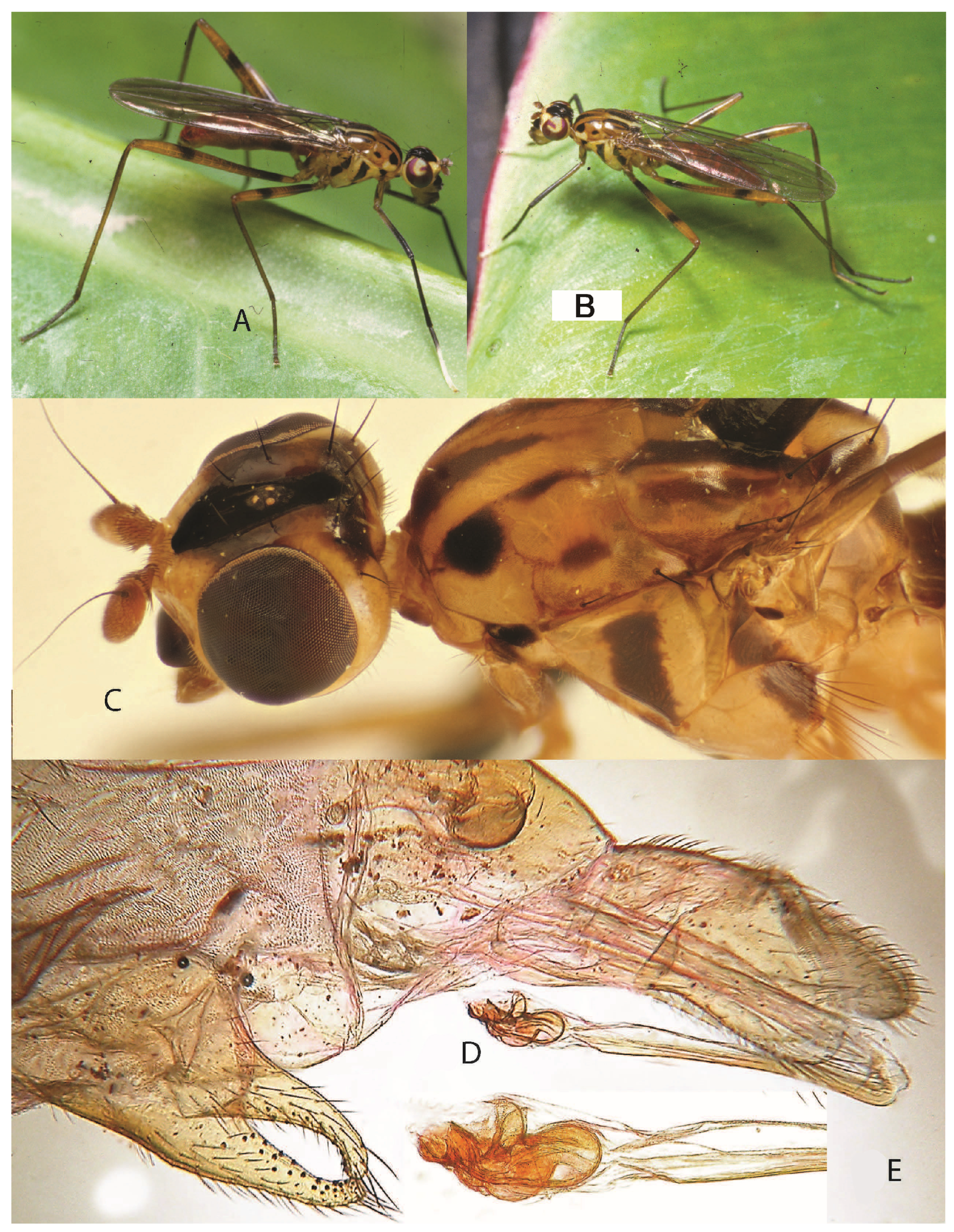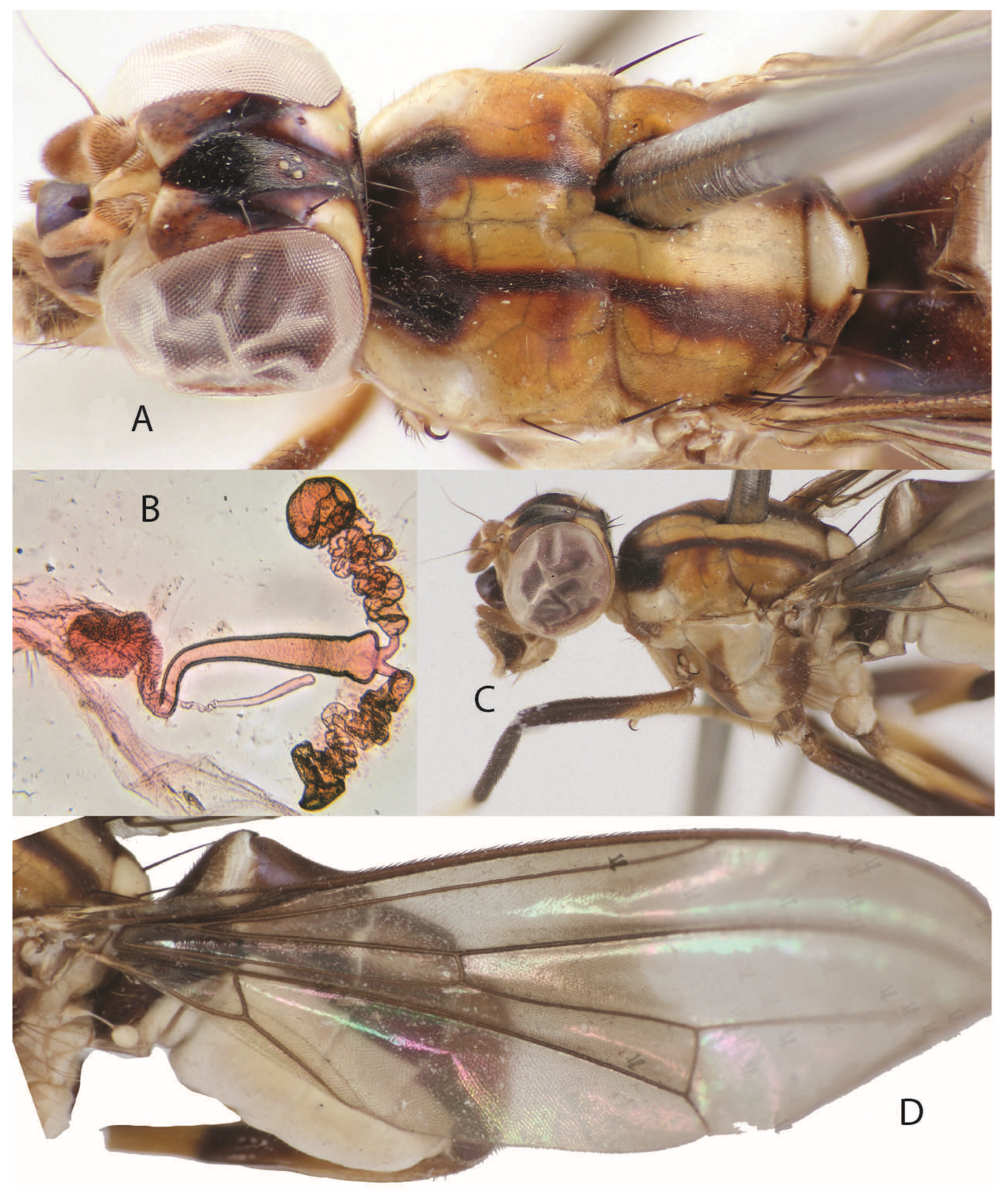3.1.7. Key to the Species of Nudopeza
1. Wing with apex darkly pigmented and with a broad, almost parallel-sided and darkly pigmented discal band entirely crossing wing (
Figure 35A). Arista bare or almost so. Head mostly black with only lower part of frontal plate yellow. Scutellum black or red, not distinctly paler than scutum. Aedeagus of known males with a large, multi-chambered phallic bulb basal to a distal distiphallus (
Figure 35D). … 2.
Nudopeza verpa group and N. zostera. Ecuador and Colombia.
Wing apex usually clear but sometimes with weak apical or preapical pigmentation; discal band usually absent, indistinct or incomplete, if distinct then tapered towards wing base and not reaching hind margin of wing. Arista bare, pubescent or plumose (plumose in species with strong wing pigmentation). Head colour variable but with at least the frontal plate pale in most species; scutellum usually pale at least centrally. Distal distiphallus absent in most known males but present and extraordinarily long in some species (
Figure 6B); phallic bulb variable. … 6. Central and South America.
2. Thorax black and orange, with pleuron orange and scutellum and at least anterior margin of scutum black. … 3
Thorax either entirely black or almost entirely orange. … 4
3. Fore coxa and trochanter black. Mid and hind femora black with narrow white mid proximal and broader preapical white bands (
Figure 41B). Anepisternum orange on anterior half, yellow on posterior half. …
Nudopeza zostera sp. nov. Ecuador. Known only from the male type.
Fore coxa and trochanter reddish brown. Mid and hind femora black with broad yellow to orange basal, subbasal and apical bands (
Figure 15D). Anepisternum orange, not distinctly bicolored. …
Nudopeza nigriscutellum sp. nov. Colombia. Known only from females.
4. Body black. … Nudopeza verpa sp. nov. in part, black morph Ecuador.
Body orange. … 5
5. All femora mostly black, mid and hind femora with basal, apical and sometimes middle orange rings. Anterior notopleural bristle present but less than 0.2× length of posterior bristle. Postpronotum orange, sometimes with a longitudinal black central area (
Figure 34A), anterior margin of scutum orange. …
Nudopeza verpa sp. nov. in part, orange morph Ecuador.
Mid and hind femora orange, slightly darkened at base. Anterior notopleural bristle absent. Postpronotum cream yellow (
Figure 38B), anterior margin of scutum black. …
Nudopeza viva sp. nov. Colombia. Known only from females.
6. Mesoscutum black or dark brown, scutellum yellowish brown to black. Epicephalon black or dark brown. Arista sparsely and indistinctly short-plumose. Pleuron brightly coloured, with anepisternum usually dark anteriorly and pale posteriorly. … 7. Nudopeza sumaco group, in part, South America. Known only from females.
Mesoscutum rarely mostly dark but if so then scutellum white, pale yellow or with a broad pale central area. Epicephalon variable but usually white to yellow. Arista bare, pubescent or plumose; if scutum and epicephalon dark then arista distinctly pubescent or plumose. Pleuron colour variable. … 12. Central and South America
7. Lower frons, including frontal plate and lower frontal vitta, orange-yellow (
Figure 8A). Mid and hind femora yellow with broad, pale, indistinct brown bands; fore femur orange on basal half. Pleuron vertically banded in reddish brown and yellow, scutum dark brown with pruinose vittae. Scutellum yellowish, scutum pruinose dark brown.
… Nudopeza gracei sp. nov. Venezuela. Known only from the female type.
Entire frontal vitta black. Mid and hind femora mostly black or mostly orange with some black areas; fore femur black. Pleuron black and white, scutum black with conspicuous silvery pruinose pattern, scutellum brown to black. … 8
8. Mesoscutum uniformly pruinose, without a strong pattern of silvery pruinose and relatively bare areas (
Figure 27E). Female abdominal segment 4 desclerotized dorsally (T4 apparently absent,
Figure 27B). …
Nudopeza sumaco sp. nov. Ecuador. Known only from the female type.
Scutum black centrally, each side with a broad longitudinal silvery vitta crossing suture and reaching scutellum, usually with a gap in the middle of the broad vitta (
Figure 15C). Female abdomen with T4 sclerotized. … 9
9. Mesonotum with postsutural vittae separated from one another by a triangular prescutellar silver marking with long edge of triangle along scutellar margin (
Figure 16C). Postsutural vittae uniform, not enclosing a small postsutural black area. One dorsocentral bristle. …
Nudopeza nigrivertex sp. nov. Ecuador, possibly Colombia. Known only from females.
Mesonotum with postsutural vittae separated from one another by an entirely dark area concolorous with dark central part of scutellum, each vitta surrounding an oblong dark area postsuturally (
Figure 33A). One or two dorsocentral bristles. … 10
10. One dorsocentral bristle. Mid and hind femora black with a broad orange subbasal ring (
Figure 36A,B). Postpronotum white only dorsally and posteriorly (
Figure 36C). …
Nudopeza versivitta sp. nov. Ecuador. Known only from females.
Two dorsocentral bristles. Mid and hind femora variably coloured but without a broad subbasal orange ring. Postpronotum all or mostly white. … 11
11. Mid and hind femora mostly black; scutellum brown at middle; anepisternum black with a white rim posteriorly, dorsally and anterodorsally (
Figure 37D). …
Nudopeza viriola sp. nov. Bolivia. Known only from the female type.
Legs mostly red, middle of scutellum black; anepisternum with posterior half or more white (
Figure 33B). …
Nudopeza venezuelensis sp. nov. Venezuela. Known only from the female type.
12. Scutellum brown to black, without a pale central area. … 13
Scutellum entirely white or (usually) with a broad pale (usually white, rarely pale brown or yellow at apex only) central band contrasting with darker lateral margins or anterior corners, white central band often continuous with a similar postsutural strip on the scutum (
Figure 31A). … 17
13. Dark part of frons restricted to frontal vitta; frontal vitta gradually tapered from a broad anterior margin to a narrow posterior margin, frons otherwise yellow to orange (fronto-orbital plate not divided by an angled dark line,
Figure 2C). Postocellar and frontal bristles absent. Postpronotum similar in colour to scutum. Arista short pubescent on basal half, bare on distal half. …
Nudopeza cegex sp. nov. Costa Rica. Known only from females.
Fronto-orbital plate with an angled dark strip from frontal vitta to eye, separating frontal and orbital plates. Postocellar and frontal bristles present. Postpronotum variable, but usually white. Arista bare or short plumose. … 14
14. Arista short-plumose, hairs at least 1.5× width of first aristomere. … 15
Arista bare or indistinctly pubescent, hairs shorter than width of first aristomere. … 16
15. Frons with a black V-shaped band sharply dividing an entirely pale lower frons (including frontal plate and lower frontal vitta) from an orange to reddish brown orbital plate or upper frons, anterior quarter of frontal vitta yellow (
Figure 6C and
Figure 7). …
Nudopeza glypha sp. nov. Costa Rica. Known only from females.
Frontal vitta black except for an orange middle area surrounding a darker ocellar triangle. Frons without a distinct V-shaped band, frontal and orbital plates divided by an indistinct pale line between brown frontal and orbital plates (
Figure 43B). …
Nudopeza zygoma sp. nov. … Guyana. Known only from the female type.
16. Thorax almost entirely uniformly orange except for a small black dot above the orange postpronotum and a narrow vertical yellow stripe on the posterior margin of the anepisternum (
Figure 25A). Frontal plate white, orbital plate black. Mid and hind femora black with white rings. …
Nudopeza rutilans sp. nov. Peru. Known only from females.
Mesoscutum brown, with reddish brown longitudinal bands; scutellum brown with a white margin; anepisternum pale yellow with a white posterior margin. Mid and hind femora pale orange with dark rings. Frontal and orbital plates similarly pale, divided by a broad angled black band extending from frontal vitta to eye (
Figure 5C). …
Nudopeza gilli sp. nov. Guatemala.
17. (scutellum white or pale at least centrally):
Lower frons with at least anterior part of frontal plate yellow and orbital plate all or mostly dark (usually entirely black,
Figure 18A). Arista bare or nearly so, at most indistinctly pubescent. … 18
Lower frons crossed by black V-shaped mark dividing a yellow frontal plate (in front of black V) from an all or partly pale yellow to yellowish brown orbital plate (behind black V). Arista bare to plumose. … 21
18. Scutum mostly dark brown other than a narrow white to reddish posteromedial strip extending to scutellum. … 19
Scutum black between the white postpronota, otherwise orange with a broad white postsutural posteromedial strip extending to scutellum. … 20
19. Two dorsocentral bristles. Mid and hind femora black with orange bands and apex (
Figure 19A). Oviscape black or dark brown. Abdominal pleuron with broad vertical black bands (indistinct on some specimens). Spermathecal stem broad, with long digitiform processes but not coiled (
Figure 19E). …
Nudopeza paramephitis sp. nov. Ecuador.
One dorsocentral bristle. Mid and hind femora mostly red: mid femur with a narrow black distal band, hind femur also with a basal band (
Figure 12D). Oviscape red at base. Abdominal pleuron pigmented dorsally but pigmentation not forming vertical bands. Paired spermathecal stems tightly coiled (
Figure 12E). …
Nudopeza mephitis sp. nov. Peru.
20. Mid and hind femora yellow with four narrow dark bands (
Figure 22A). Paracephalon black, contrasting with white postgena. Primary spermathecal duct uniform in width (
Figure 22D). …
Nudopeza pronigra (Hennig). Bolivia, Ecuador.
Mid and hind femora orange except for a broad black basal band and a narrow preapical band (
Figure 24B). Paracephalon and postgena yellow. Primary spermathecal duct expanded distally (
Figure 24C). …
Nudopeza ruficincta sp. nov. Colombia. Known only from females.
21. Postocellar bristle absent and arista short-pubescent, almost bare. Scutellum brownish yellow, central pale area only slightly paler than scutum. Scutellum short and truncate, much less than half as long as wide (
Figure 17A).
… Nudopeza nudarcuata sp. nov. Peru. Known only from female type.
Postocellar bristle usually present, if reduced or absent then arista long plumose. Central part of scutellum conspicuously paler than scutum. Scutellum more than half as long as wide. Arista bare or plumose. … 22
22. Arista bare or nearly so, at most with indistinct pubescence shorter than width of first aristomere. Frontal vitta entirely black. … 23
Arista plumose. Frontal vitta entirely black or with black area interrupted over or behind ocelli. … 25
23. Notum mostly orange except for black suprahumeral spot and narrow vittae (
Figure 39C). Frontal vitta broad throughout. Epicephalon (anterior and inner part of orbital plate) mostly dark and paracephalon (outer part of orbital plate) pale. …
Nudopeza yungasensis sp. nov. Bolivia. Known only from males.
Notum almost entirely dark brown to black. Frontal vitta narrowed posteriorly, black throughout and contrasting with yellow epicephalon. … 24
24. Hind tarsomeres and tibia brown. Female with two dissimilar pairs of spermathecae, pair on larger duct elongate and twisted, tapered apically (
Figure 3B). …
Nudopeza cura sp. nov. Costa Rica.
Hind tarsomeres white, contrasting with brown tibia. Female with two pairs of similar spermathecae, pair on larger duct slightly longer, broadest apically (
Figure 28C). …
Nudopeza tapanti sp. nov. Costa Rica.
25. Frontal vitta entirely black from anterior margin to postocciput, contrasting sharply with yellow frontal plate and epicephalon. … 26
Frontal vitta not entirely black, either divided over ocelli or conspicuously paler posteriorly or anteriorly. … 29
26. Scutum mostly black with three large white to yellow areas postsuturally (
Figure 11C). Oviscape uniformly brown. …
Nudopeza laselva sp. nov. Costa Rica.
Scutum mostly orange with black vittae. Oviscape orange with longitudinal black strip dorsally … 27
27. Lateral margin of scutum dark brown from postpronotum to scutellum (
Figure 10B). Palpus dark brown. Lower epicephalon dark, orbital and frontal plates therefore separated by a broad dark area. Anepisternum black except for narrow white margins. …
Nudopeza horologia sp. nov. French Guiana, Brazil.
Lateral margins of scutum without extensive dark areas. Palpus all or mostly orange. Lower epicephalon pale right to the narrow dark strip dividing orbital and frontal plates. Anepisternum at least half white. … 28
28. Mesonotum with a central presutural vitta and sometimes two short postsutural vittae (
Figure 26A). Frontal and orbital plates entirely pale, with a narrow angled black strip between them. Mid and hind femora pale orange with narrow black bands. Female T3 and T4 white with a black posterior margin. Paired spermathecal stems with a few twists on distal half only, less than 1/4 as long as duct.
… Nudopeza sirena sp. nov. Costa Rica. Known only from females.
Scutum with two complete dark vittae running from anterior margin to scutellum but without a central vitta. Frontal plate reddish brown, yellow on inner anterior margin only. Orbital plate yellow posteriorly, reddish anteriorly, separated from frontal plate by a broad dark area. Mid and hind femora black with yellow bands. Female abdominal tergites brown. Paired spermathecal stems almost entirely tightly coiled and more than half as long as spermathecal duct (
Figure 40B). …
Nudopeza zarza sp. nov. Trinidad. Known only from females.
29. Scutum either mostly dark or conspicuously patterned, at least part posterior to suture with white or brown vittae (
Figure 9A). … 30
Scutum mostly uniformly orange to pale reddish brown, orange postsuturally. … 37
30. Hind femur orange to yellowish brown, with dark brown ring basally, distal dark ring present or absent. Frontal vitta expanded anterior to ocelli, colour variable but never entirely black from ocelli to anterior margin of frons. Known males without a distal distiphallus. … 31
Hind femur pale orange with only a single weak brown ring in distal quarter. Frontal vitta narrow and parallel sided, black from ocelli to anterior margin but pale behind ocelli. Distal distiphallus very long and male sternite 5 strikingly elongate (
Figure 13C). …
Nudopeza mexicana sp. nov. Mexico.
31. Scutum shining black or reddish brown except for black suprahumeral spots, white or yellow postpronota and three short yellow to white vittae on posterior half. Anepisternum brown with white anterior and posterior margins. Lower part of epicephalon black or dark brown. … 32
Scutum yellowish orange with dark vittae and a broad white postsutural strip continuous with white of scutellum. Anepisternum mostly white, with anterior third or middle strip brown. Epicephalon almost entirely pale, leaving a narrow dark dividing line between pale orbital and frontal plates. … 33
32. Scutum mostly shiny black. Frontal vitta mostly black, continuous with black postocciput posteriorly but not reaching anterior margin of frons, lower frons thus entirely white to yellow. Female abdominal T3 black, T4 greatly reduced so segment 4 almost entirely membranous and pale (
Figure 14C). Spermathecal ducts unequal, minor duct much shorter and narrower than the major duct that leads to two large spermathecae on long, ornamented stems (
Figure 14D) …
Nudopeza micromephitis sp. nov. Colombia, possibly Brazil.
Scutum mostly shiny reddish brown. Preocellar frontal vitta black on anterior 2/3, otherwise dark brown. Female T3 pale, other tergites brown (
Figure 21C). Spermathecal ducts similar in length, one leading to a very large single spermatheca and the other leading to small paired spermathecae (
Figure 21D). …
Nudopeza peruviensis sp. nov. Peru. Known only from unique female type.
33. One dorsocentral bristle. Palpus and postpedicel orange. … 34
Two dorsocentral bristles. Palpus and postpedicel brown. … 36
34. Notopleuron uniformly brown or yellowish brown. Posterior part of postocellar frontal vitta black. Scutum without a dark presutural central vitta, but with a dark area or areas between the black suprahumeral spots (
Figure 23A,B). … 35
Notopleuron white on posterior half, black on anterior half (
Figure 31A). Postocellar vitta pale orange. Scutum with a black presutural central vitta. …
Nudopeza uniseta sp. nov. Trinidad. Known only from male type.
35. Postocellar bristle absent. Anterior part of scutum with anterior black area divided into two patches contiguous with large suprahumeral spots. Abdominal T3 almost entirely white and desclerotized except for a narrow posterior margin; T4 also mostly white (
Figure 23A), oviscape blue-black. …
Nudopeza quadrivitta sp. nov. French Guyana. Known only from female type.
Postocellar bristle present and well developed. Anterior part of scutum with a posteriorly tapered central black area much larger than small suprahumeral spots (
Figure 42A). Abdominal T3 dark on posterior third, T4 dark on posterior half or more, oviscape orange-yellow with a dorsal black vitta. …
Nudopeza zumera sp. nov. French Guyana. Known only from female type.
36. Postpedicel and pedicel similar in colour. Frontal vitta mostly dark orange but pale anteriorly. Presutural scutum broadly black between white postpronota (
Figure 29A). Thoracic pleuron with dark vertical bands on anepisternum and katepisternum. Abdominal T3 partially brown, white anteriorly (male) or centrally (female); female P4–6 dark along dorsal margins only.
… Nudopeza trinidadensis sp. nov. Trinidad, Ecuador, Peru.
Postpedicel much paler than pedicel. Frontal vitta mostly black but broken by a broad pale orange band over ocelli. Presutural scutum orange with black central vitta and a round suprahumeral spot (
Figure 9A). Thoracic pleuron pale brown and white. Female T3 entirely pale and desclerotized, P4 with a ventrally tapered vertical dark band. Wing clear. …
Nudopeza hansoni sp. nov. Costa Rica. Known only from female type.
37. Postocellar bristle absent or very small, less than half as long as outer verticals. Arista long-plumose, rays usually at least as long as scape width at base. Female abdomen with all or almost all of T3 white or pale. Frontal vitta pale at anterior margin. … 38
Postocellar bristle as large as outer verticals. Arista short-plumose, rays at most half as long as scape width. At least posterior third of T3 dark. Frontal vitta dark to anterior margin. … 39
38. Head entirely pale brown behind ocelli. Oviscape strongly modified with a large, setose and brown preapical ventral swelling and a smaller preapical black swelling basal to a spout-like narrow apical extension (
Figure 20B). Scutum with a weak brown presutural vitta, suprahumeral spots undeveloped. Five (3 + 2) spermathecae. …
Nudopeza penai sp. nov. Ecuador. Known only from female type.
Most of postocellar frontal vitta orange, back of head black. Oviscape simple, unmodified. Scutum with a central black presutural vitta and dark suprahumeral spots (
Figure 4A). Four spermathecae.
… Nudopeza duplitheca sp. nov. Peru, possibly Brazil.
39. Two dorsocentral bristles. Preocellar frontal vitta broad and entirely black, postocellar frontal vitta mostly black with a narrow orange postocellar strip (
Figure 32A). Palpus black on basal 2/3. …
Nudopeza variterga sp. nov. Costa Rica.
One dorsocentral bristle. Preocellar frontal vitta mostly black but with a narrow orange strip below ocellar triangle; postocellar frontal vitta either all black or mostly orange. Palpus entirely yellow (N. arcuata) or brown with a pale apex (N. palenque). … 40
40. Top of head, including orbital plates and postocellar frontal vitta, almost entirely black (
Figure 19A). Palpus brown with a pale apex. Female abdomen boldly pigmented with narrow dark vertical stripes on P3–6 and with T3 mostly brown, white area restricted to anterolateral areas and a narrow anterior strip. …
Nudopeza palenque sp. nov. Ecuador. Known only from females.
Top of head, including most of the orbital plate and sometimes part of the postocellar frontal vitta, largely orange. Palpus entirely yellow. Female abdominal pleuron with at most one vertical dark stripe. Female T3 white on at least anterior third. … 41
41. Postocellar frontal vitta black with white pruinosity. Wing with a small discal spot restricted to centre of wing between R and Cu. Mesoscutum without a black spot or area near postpronotum (
Figure 44B). Female abdominal pleuron without marks other than a single vertical black band on the posterior part of P2. …
Nudopeza zytha sp. nov. Colombia. Known only from female type.
Postocellar frontal vitta orange except for posterior margin (
Figure 1A). Wing with discal band or spot wider than long, forming a diffuse band crossing most of the wing. Mesoscutum with a black spot or area immediately beside postpronotum. Female abdominal pleuron with black markings on P4 and P5. …
Nudopeza arcuata (Hennig) Peru, Bolivia.
